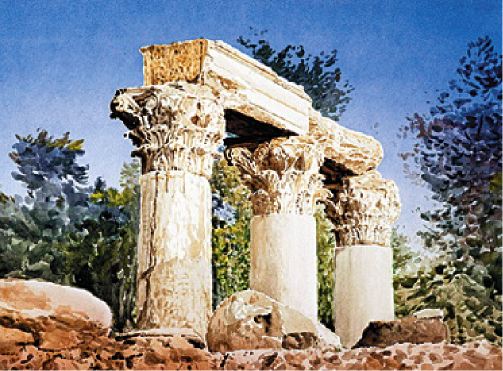 |
||
|
Intimately Greek The splendour of nature and the special quality of Greek light are captured in the paintings of Nicholas Egon, currently on display at the Benaki Museum |
||
|
By Edward Lucie-Smith
AT FIRST glance Nicholas Egon's images of Greece look like the highly accomplished topographical drawings and watercolours produced by the western European artists who visited Greece in the 19th century - Edward Lear, William Muller or their French, German and Italian contemporaries. It takes only a brief scrutiny to confirm that this is a false analogy. Egon has a level of technical accomplishment now denied to most contemporary artists. In this sense he is 'traditional', completely at home with the achievements of the past. His paintings are telling of his history and experience in Greece. In his new exhibition at the Benaki Museum, there are portrait drawings that date back to the late 1940s, the tail-end of the Greek civil war. |
 Egon's watercolour and pastel 'Three Columns, Temple of Olympian Zeus, Corinth' (1993) |
|
|
The majority of the drawings, however, belongs to the last three decades and represents an ever-deepening effort to understand Greek light and the Greek landscape. There are no figures in these works, except a few tiny ones, seen in the far distance. Very few of the drawings include architectural elements - the columns of the Apollo Temple at Corinth, a ruin that is very close to where he lives, are pictured in one work, for example. A large number are closeups of things that most people would pass without giving a second glance - a couple of gnarled olive trees, a patch of wildflowers interspersed with a few rocks, grass stalks in closeup, with Mount Olympus in the background. These drawings all have a strong principle of organisation, and that principle is not traditional but Modernist. The flowers and grasses are pictorial incidents, depicted with the kind of accuracy a professional botanist would admire. However, this is just a kind of 'skin', or veil. Underneath this apparent truth to appearances lies the kind of rhythm familiar from the Abstract Expressionist paintings of the mid-20th century. The Abstract Expressionists used to speak about 'all-overness', by which they meant a kind of composition that filled the whole canvas, edge to edge, and which kept the eye continually shutting across the whole pictorial space. Though much smaller in scale than typical Abstract Expressionist paintings, Egon's drawings of Greek landscape do the same thing. One can see, from earlier works, how Egon arrived at this method of composing. There are some early paintings that are completely abstract. There are also drawings made of desert landscapes in Saudi Arabia and in Jordan, where the same methods are at work. In these, too, what previous generations would have thought of as a definable subject is usually absent. In the circumstances, one has to ask what the artist's motivation is in making these works - what kind of obsession drives him forward. The Abstract Expressionists were essentially narcissistic, concerned to give form to their own subjectivity, which they assumed would be of interest to everyone who looked at their work. Mark Rothko famously said that he wanted his paintings to make people weep without them knowing why. That is clearly not the purpose here. The drawings are about quietude, about loving attention to what is seen. Above all, I think they are about a love affair. Egon is not Greek by birth. However, like many people who come to Greece, he has been struck by the special magic of Greek nature. And, above all, by the special quality of Greek light. What he wants to do is convey the sensations nature and light produce within his own psyche. In this sense his works are, of course, subjective - something that is true of all artworks, both good and bad. Yet they are also a kind of gift to the spectator. What they say is: "I saw this, and you can see it too." * Nicholas Egon in Greece is on at the Benaki Museum (1 Koumbari St, tel 210-367-1000) through to May 20. Open: Monday, Wednesday, Friday and Saturday 9am-5pm; Thursday 9am-midnight; Sunday 9am-3pm; Tuesday closed. * Of the exhibition's 46 paintings, 43 will be on sale and proceeds will go to aid the museum. The monograph 'Nicholas Egon' by Fani-Maria Tsigakou is available for 40 euros from the museum's gift shop |
||
|
|
||
|
|
||
|
|
||
(Posting date 9 May 2007)
All articles of Athens News appearing on HCS have been reprinted with permission. |
||
|
||
|
2000 © Hellenic Communication Service, L.L.C. All Rights Reserved. http://www.HellenicComServe.com |
||

